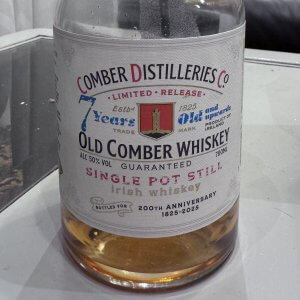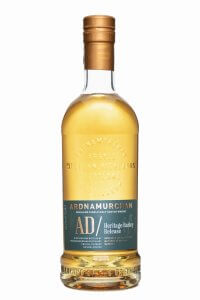The Weekly Mash, Friday 14th November
Keep Whisky Weird

Was it a surprise? Perhaps not. I’d had a sneak preview of one of the components in the soon to be released Old Comber 7yo 200th Anniversary release at The Whisky Show and was suitably blown away. That’s the 200th anniversary of the founding of the distillery, close to Belfast which shut in 1953. This tribute has been made at Echlinville using estate-grown barley, some of which has been floor-malted. The rest, this being a single pot still, remained unmalted. Ageing has been in ex-Port and -sherry casks.
Still, I wasn’t fully prepared for the aromas which seethed from the glass. Comber was noted for being the only distillery in Northern Ireland which exclusively made single pot still – and doing it double distilled.
This is unreconstructed old style pot, teetering on the right side of filth, slathered in oils, that double distillation adding the weight. The nose is reminiscent of the cod liver oil I was force-fed as a child before there’s a whiff of tack room (hay, saddle soap). When tasted, there’s less of the juicy fruits you might be familiar with, and more raisin, sloe, ginger and a fade into liquorice. A superb, robust a meal of a whiskey. Stay alert for its launch.

It made me wonder again about the role which the weird has in modern whisky-making, not just here in Ireland, but anywhere in the world.
It is hard for the majors to set the pace stylistically. By their nature they will be the mainstream: the largest in terms of volume, reach, and the need to appeal to a wider demographic.
Decision-making is slower, small batches are often impossible, the logistics in terms of distribution, and marketing become difficult.
While it’s possible for them to try something radical, more often than not it is an awkward fit. Japan has managed to do it, Scotch has been less successful.
The lead in any craft or art will always come from the fringes. It could be music, food, art, fashion. The real innovators are out there, testing the ground. Slowly, some of these ideas filter in, become absorbed into the mainstream, then the cycle begins again. If this weren’t to happen in whisky it would sinks into a swap of mediocrity – an interchangeable array of perfectly nice, generic ‘single malt flavoured’ whiskies.
There is also a commercial necessity for the smaller producers to do this. It is easy to get lost by playing safe. They cannot compete with the big brands, the economies of scale are not in their favour. Being ‘weird’ is therefore also a matter of survival. You need the midges nipping your legs to get them moving and dancing again. That spur, that injection of energy, that ‘what if?’ is vital.
As ever it is a matter of balance. We need that that reassuring safe dram, but homogenised ‘malt whisky flavour’ will not entice or excite retailers, bartenders or consumer (old or new). It is another element in the debate over ways in which to energise the category.
Sensible pricing is one aspect, selling and finding stories another, but so is flavour and diversity. All are linked. This Old Comber isn’t therefore only a celebration of an anniversary, it is part of an important movement within whisky as a whole – and within the evolution of the new Irish category.

Ireland is a fascinating test case within whisky because it is simultaneously old (as old as Scotch) yet as the result of the collapse of the industry in the 20th century, is also new. Many of its newest brands have been built on the supply of third party whiskey, but are now heading towards a critical decision point.
The sourced whiskey was needed to help establish new distilleries, but with everyone drawing from the same well (Cooley to begin with, now Great Northern) there was always the danger that the differences between brands would be small unless they were cleverly blended and a wholly individual style created – the Dunville’s brand (also from Echlinville) being an example.
With distilleries’ own stock now mature do they blend seamlessly from sourced to their own make, or have a sourced brand and their own (Boann’s The Whistler and its eponymous whiskeys for example)? Should they make a clean break?

GND isn’t going to stop producing high volumes of easy-drinking single malt, so if you take the first option, there is the risk of becoming one of many identikit whiskeys? To avoid that elephant trap, it seems to me at least, Ireland’s new smaller distillers need to embrace the weird and that means single pot still.
The same principles apply to any country, which makes me wonder whether whisky’s future might look similar to wine – some major brands but the majority of the interesting work being done by small individual producers, the best of whom are adding richness and diversity. Not so much following the path, but heading into the wilds to create a new one.
————
In My Glass
 Ardnamurchan AD/Heritage Barley (59.2%/£69.95)
Ardnamurchan AD/Heritage Barley (59.2%/£69.95)
Golden Promise was the workhorse of Scotch from the ‘60s until the late ‘70s when it was usurped by higher-yielding varieties. What was lost? Texture, but also flavour.
This release of a 100% GP from Ardnamurchan was aged in ex-Bourbon casks since 2018, and is unpeated. There’s soft fruits on the nose, a hint of nutty fresh cereal, and a back note of an almost meaty sweetness, mixed with tamarind. With water it strikes a lovely balance between vanilla, sweet chestnut, nougat and chocolate and hot buttered muffins.
Ardnamurchan is oily spirit anyway, and the use of GP just builds on that. It manages to taste ‘old’ in the same way as whiskies from the GP era do, suggesting that the depth and sense of over-ripeness in the fruits you get on these isn’t down to long maturation, but a quality driven by the barley.
There’s hazelnut, Danish oil, fine tannins, savoury spice, and lemon marmalade. It needs dilution to calm things down and broaden the effect of the honeyed sweetness with the distillery’s mineral finish adding a final frisson.
 Ardnamurchan AD/10 year old, 46.8%/£60
Ardnamurchan AD/10 year old, 46.8%/£60
Now a permanent member of the range, this is a vatting of mainly ex-Bourbon casks with a splash of ex-sherry hoggies. The distillery makes peated and unpeated. This is a 48:52% split.
There’s distinct minerality from the start, juicy fruits. The smoke remains in the background smoke allowing slightly tart citrus to come forward alongside pear (pear drops even) and melon. Gentle, refreshing with a touch of custard creams, and coconut. Water brings out a drier note and some cold butter.
On the palate, the sherry adds just enough black fruits and structure. There’s some hessian-like dryness, but the purity of fruit is the critical factor here. Gentle oils coat the palate with estery brightness flying above and those darker fruits maintaining the bass line. It comes to life when water’s added with some elderflower cordial, a little jasmine and a green bite. Balanced, vivacious, smoked, fruity, slightly saline, and a great price. What are ye waiting for?
—————————–

Kilchoman Single Casks
Here’s a couple of Kilchomans which I first tried at the recent 20th anniversary party. I wasn’t carrying pen and notebook on the evening, but have managed to purloin two of them. They’re not commercially available as far as I know, but are great examples of the distillery as it moves into middle age.

Kilchoman 2007 cask #307 49.8%
Drawn from a fresh oloroso butt, this blows away any thoughts that Kilchoman is somehow a lighter style of peated whisky. It has weight, and can cope with 18 years in a fresh oloroso butt, and still show its distillery character. It mixes heather blossom and root with polished furniture, a touch of pitch pine, incense, eucalypt but somehow also remaining lifted.
The palate has immediate smoke wrapped in a mix of candied ginger, walnut, leather oils, sandalwood and balancing sour fruits. In time there’s an added curried element: turmeric, curry leaf, as well as chocolate. Towards the back you get bittersweet root and spices, purple smoke, sage, then stout-like maltiness before a final release of date and fig.
If young Kilchoman heads to the sand dunes, maturity returns it to the peat stacks – a contrast in location and season – young is spring, this is autumn.
Kilchoman 2009 cask#937 51%
This in an usual one as it is made from unpeated barley (though there’s more than a tickle of smoke). It’s been aged in a refill oloroso butt. Initially it is drier than the 18-year-old with some slightly splintery wood/fresh pencil shavings before it starts to move in a more mysterious way. There’s old coins, a hint of root beer, and wet grass before glazed orchard fruits come through with warm, sticky cardamom buns. Water adds a menthol note and sage.
The palate is very lightly smoked at the start but then, hello!, peaches, and nectarines edging toward the tropical – that classic refill + age thing which sometimes happens.
It’s a slinky dram with lush fruits and a comforting feel: wax polish, peach skin but with enough savouriness to adds depth. It oozes into a dried mango finish, all the time winking at Bowmore as if to say, ‘ I can do this as well you know.’
In My Ears
Heart still thrilling from a superb session at The Hut in Phibsborough, plus that Old Comber means a whack of traditional Irish music is required. Here’s a classic from Noel Hill and Tony MacMahon